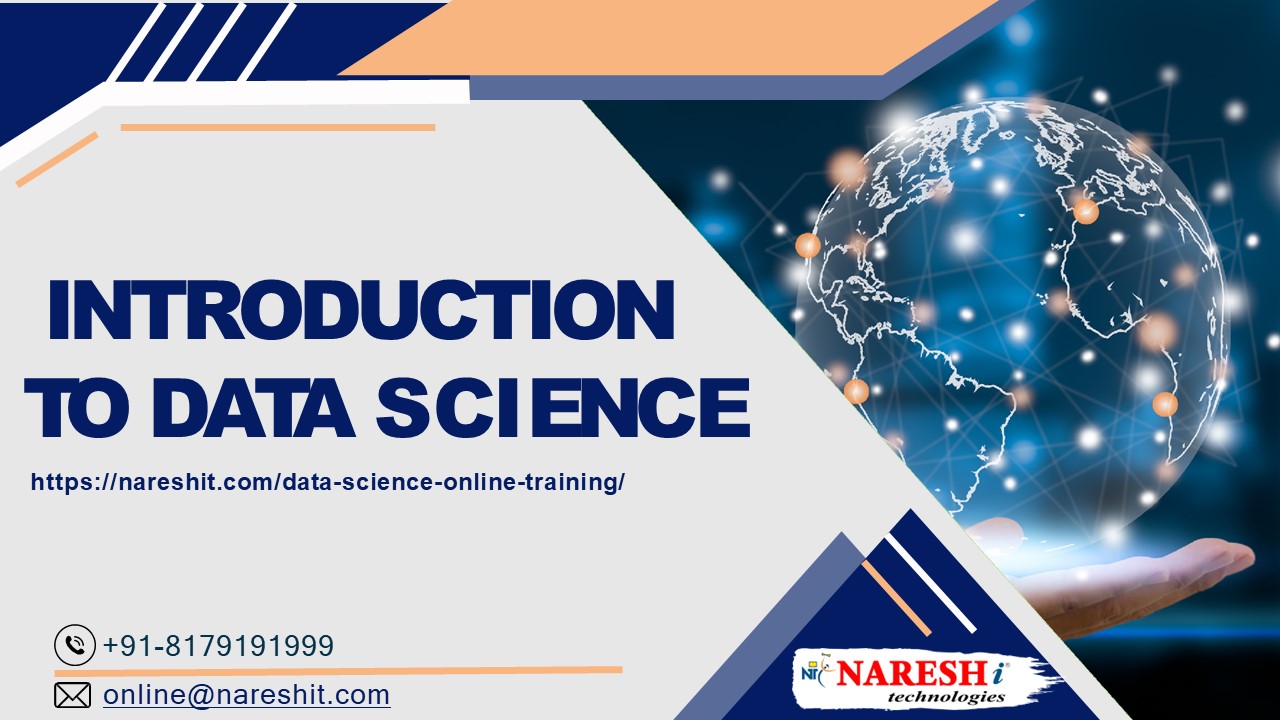Introduction of Data Science - NareshIT - PowerPoint PPT Presentation
Title:
Introduction of Data Science - NareshIT
Description:
Definition of Data Science: Data science is an interdisciplinary field that uses scientific methods, processes, algorithms, and systems to extract knowledge and insights from structured and unstructured data. – PowerPoint PPT presentation
Number of Views:1
Title: Introduction of Data Science - NareshIT
1
INTRODUCTION TO DATA SCIENCE https//nareshit.com
/data-science-online-training/
91-8179191999 online_at_nareshit.com
2
DATA SCI ENCE TOO LS AND TECH NOLOGI ES
01
04
I NTRODUCTI ON TO DATA SCI ENCE
T ABLE OF CONT ENT
02 DATA SCI ENCE
05 E TH ICAL
LIFECYCLE
CONSI DERATI ONS I N DATA SCI ENCE
03 APPLI CATI ONS OF
DATA SCI ENCE
3
Introduction to Data Science
Definition of Data Science Data science is an
interdisciplinary field that uses scientific
methods, processes, algorithms, and systems to
extract knowledge and insights from structured
and unstructured data. Importance of Data
Science Data science plays a crucial role in
making data- driven decisions, solving complex
problems, and unlocking valuable insights for
businesses and organizations. Key Components of
Data Science Data collection, data cleaning and
preprocessing, exploratory data analysis,
statistical modeling, machine learning, and data
visualization. https//nareshit.com/data-science-o
nline-training/
4
Data Science Lifecycle
Data Acquisition Collecting data from various
sources such as databases, APIs, web scraping,
or sensors. Data Preparation Cleaning,
transforming, and preprocessing the data to
ensure its quality and compatibility for
analysis. Exploratory Data Analysis (EDA)
Analyzing and visualizing the data to identify
patterns, trends, and relationships. Modeling and
Evaluation Developing statistical models and
machine learning algorithms to solve specific
problems and evaluating their performance. Deploym
ent and Communication Implementing the models
into production systems and effectively
communicating the results to stakeholders. https/
/nareshit.com/data-science-online-training/
5
Applications of Data Science
- Business Analytics Using data science to extract
insights from customer behavior, market trends,
and operational processes to drive business
strategies. - Predictive Analytics Building models to forecast
future outcomes and make predictions in various
domains such as finance, healthcare, and
marketing. - Natural Language Processing (NLP) Applying data
science techniques to understand and process
human language, enabling tasks like sentiment
analysis and language translation. Recommender
Systems Developing algorithms to provide
personalized recommendations to users, such as
movie recommendations on streaming platforms. - Fraud Detection Leveraging data science methods
to identify and prevent fraudulent activities,
such as credit card fraud or cybersecurity
threats. - https//nareshit.com/data-science-online-training/
6
Data Science Tools and Technologies
Programming Languages Python, R, and SQL are
commonly used programming languages in data
science for data manipulation, analysis, and
modeling. Data Visualization Tools like Tableau,
Power BI, and Matplotlib help create visual
representations of data to communicate insights
effectively. Machine Learning Libraries Popular
libraries such as scikit-learn, TensorFlow, and
PyTorch provide pre-built algorithms and
frameworks for machine learning tasks. Big Data
Technologies Apache Hadoop, Spark, and NoSQL
databases enable processing and analysis of
large-scale datasets. Cloud Platforms Services
like AWS, Azure, and Google Cloud provide
scalable infrastructure for storage, processing,
and deploying data science applications. https//n
areshit.com/data-science-online-training/
7
Ethical Considerations in Data Science
- Privacy and Security Ensuring the responsible
handling of personal data, protecting user
privacy, and safeguarding against data breaches. - Bias and Fairness Addressing biases in data
collection and modeling that can lead to unfair
outcomes or discrimination. - Transparency and Explainability Making data
science models and algorithms more interpretable
and providing explanations for their predictions
and decisions. - Data Governance Establishing guidelines and
policies for data handling, storage, and access
to ensure compliance with regulations and ethical
standards. - Accountability Taking responsibility for the
consequences of data science practices and being
accountable for the impact on individuals and
society.
8
WHO CAN LEARN DATA SCIENCE?
Data science is a field that is open to anyone
who is interested in learning. While a
background in mathematics, statistics, computer
science, or a related field can be helpful, it
is not a strict requirement. With the right
mindset and a willingness to learn, anyone can
become a data scientist.
9
THE FUTURE OF TECHNOLOGY DATA SCIENCE
Data Science in the Present Briefly summarize
the current state of data science and its impact
on various industries. Importance of Looking
Ahead Explain the need to explore the future of
technology in data science to stay ahead of the
curve and harness its potential.
10
GET MORE INFORMATION
91-8179191999 WWW.NARESHIT.COM DURGA BHAVANI
COMPLEX, 2ND FLOOR, SATYAM THEATRE RD, GAYATRI
NAGAR, AMEERPET, HYDERABAD, TELANGANA 500016
11
THANK YOU
https//nareshit.com/data-science-online-training/































